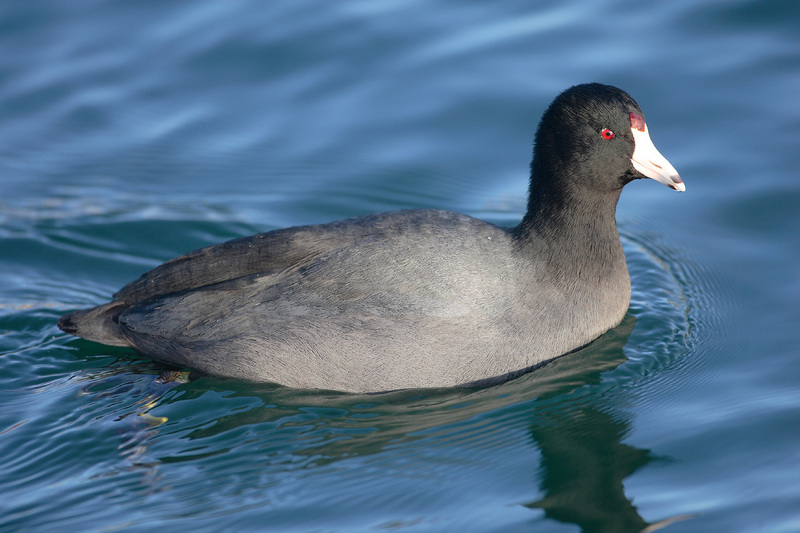American Coot (Fulica americana) - Wiki American Coot
From Wikipedia, the free encyclopedia
[Photo] American Coot -- Humber Bay Park (East), Toronto, Canada -- 2006 March. Photo by http://en.wikipedia.org/wiki/User:Mdf
The American Coot (Fulica americana) is a bird of wetlands and open water of the family Rallidae. About 40 centimeters (16 inches) in length and weighing 0.65 kg (1.4 lb), adults have a short thick white bill and white frontal shield, with a reddish-brown spot near the base of the bill between the eyes. The body is grey with the head and neck darker than the rest of the body. Their legs are yellowish, with scalloped toes rather than webbed feet. Their chicks have black bodies with bright red head and beak, and orange plumes around the neck.
Their breeding habitat is marshes from southern Quebec to the Pacific coast of North America and as far south as northern South America. They nest in a well-concealed location in tall reeds. They are frequently seen swimming in open water.
They migrate from northern locations to the southern United States and southern British Columbia. They are often year-round residents where water remains open in winter.
These birds can dive for food but can also forage on land. They are omnivorous, eating plant material, insects, fish, and other aquatic animals. Their call is a high-pitched squeaking honk somewhat like a goose's but more hollow sounding.
American Coots are highly territorial during the breeding season, with both males and females fighting with neighbors to maintain a small territory where they obtain all their food. The females are known to lay eggs in neighbors' nests (conspecific brood parasitism); contrary to what one might expect, this behavior is more common among females that already have a nest than among those that were not able to secure a suitable territory for breeding in that season (Lyon, 1993).
These chunky birds require a great deal of effort to become airborne, pedaling across the water with their feet before lifting off. The way in which their heads bob when they walk or swim has earned them the name "mud hen".
Although coots seem rather weak fliers, like most rails they have considerable stamina once airborne. This species has crossed the Atlantic to reach western Europe at least 23 times since records began, including 12 records in the Azores and four in Great Britain. In December 2003, an individual of this species attempted to overwinter in the Shetland Islands, Scotland.
Coot fossils from the Middle Pleistocene of California have been described as Fulica hesterna but cannot be separated from the present-day American Coot (Olson, 1974). However, the Pleistocene coot Fulica shufeldti (formerly F. minor) quite possibly was a paleosubspecies of the American Coot (as Fulica americana shufeldti), only differing slightly in size (Jehl, 1967).
On the Louisiana coast, the cajun word for coot is pouldeau (pool doo). It is an ingredient for gumbos cooked at home by duck hunters.
http://en.wikipedia.org/wiki/American_Coot
| The text in this page is based on the copyrighted Wikipedia article shown in above URL. It is used under the GNU Free Documentation License. You may redistribute it, verbatim or modified, providing that you comply with the terms of the GFDL. |
